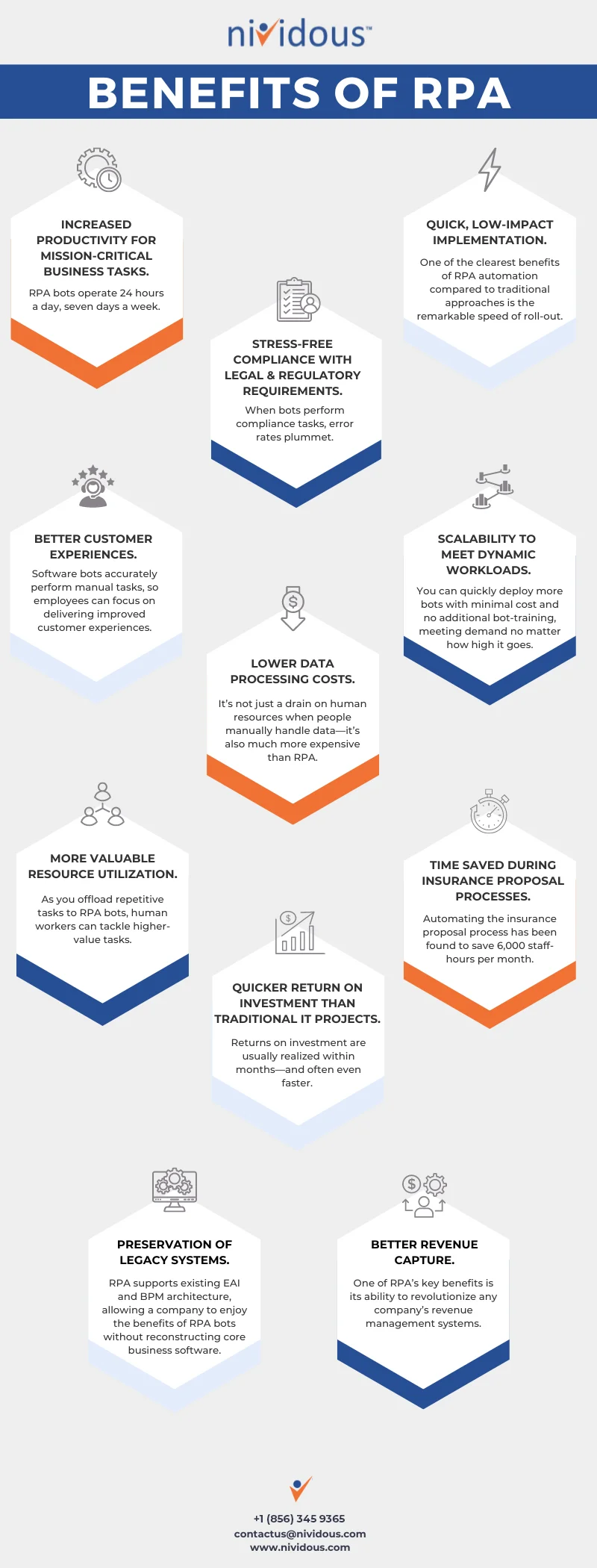Editor’s note: Tired of tedious tasks? Calculate your RPA savings now!
The Nividous ROI calculator helps you estimate the financial benefits of automating repetitive processes. Click here to see how much you can save with RPA!
The global Robotic Process Automation (RPA) sector is expected to expand at a compound annual growth rate of more than 40% through 2027. Clearly, enterprises are increasingly willing to invest in RPA and advanced automation technologies for their ability to automate mundane tasks with speed and accuracy.
What is Robotic Process Automation?
RPA utilizes software robots (“bots”) to emulate human actions in performing repetitive, rules-based, high-volume tasks. These bots are programmed to interact with software applications, achieving accurate results. This leads to more efficient business processes by:
- Accelerating task completion
- Minimizing errors
- Streamlining operations
RPA frees your human resources from mundane tasks, allowing them to focus on strategic initiatives that drive business growth and operational excellence. RPA solutions are easily configurable and integrate seamlessly with existing systems, enhancing process speed and flexibility. Choose RPA if you need:
- Increased operational control
- On-demand scalability to adapt to changing business needs
Industries That Benefit from RPA
Businesses constantly seek ways to improve cost-efficiency. While automation is appealing, it’s crucial to ensure it aligns with specific business requirements.
RPA offers a transformative solution, providing scalability and agility without significant disruption. Its rapid implementation and potential for immediate ROI make it valuable across various industries:
1. Banking: Automates account management, fraud detection, transaction processing, and compliance, leading to improved customer service.
2. Manufacturing: Optimizes inventory management, accelerates production planning, and ensures consistent quality control.
3. Insurance: Automates claims processing, policy administration, and customer onboarding, improving processing times and accuracy.
4. Healthcare: Automates patient scheduling, billing, and coding, increasing data accuracy.
5. Logistics and Supply Chain: Optimizes order processing, inventory tracking, and logistics management for timely deliveries and reduced costs.
6. Life Sciences: Supports regulatory compliance, drug development, and clinical trial management.
11 Leading Benefits Of RPA
RPA serves as the foundation for Intelligent Automation (IA), empowering software bots with cognitive capabilities like Natural Language Processing (NLP) and Machine Learning (ML). This combination streamlines complex workflows and enables adaptation to dynamic environments, delivering numerous benefits, including:
1. Increased productivity
Compared to manual data-handling, Intelligent Automation bots are incredibly fast. They also operate 24 hours a day, seven days a week, driving essential processes forward while the workforce is asleep. That makes RPA ideal for high-volume, day-to-day business processes like customer onboarding.
In fact, one leading insurance company automated their onboarding process with Nividous Smart Bots (Bots powered by the Nividous platform’s native AI capabilities) to achieve a 60% reduction in Full Time Equivalent (FTE), a measure of the time it would have taken human employees to complete this work.
Read the case study on customer onboarding process automation.
2. Stress-free regulatory compliance
Robotic process automation is particularly helpful for companies that operate in highly regulated environments like healthcare, insurance, and financial services. When bots perform compliance tasks like reconciliations and routine controls, error rates plummet.
Healthcare provider Kane Wound Care uses Nividous AI-powered Bots to translate patient documentation into billing codes and invoices. With intelligent automation, Kane Wound Care’s coding accuracy improved by 90%.
Read the case study on automating the medical coding and billing process.
3. Faster implementation
One of the clearest benefits of RPA automation, compared to traditional approaches, is the remarkable speed of roll-out. Traditional automation requires developers to create custom integrations or new software platforms altogether. That could take many months, even years.
Smart Bots from Nividous learn to use the systems that are already in place—which is why automations built on the Nividous platform can start production in just weeks, without changing the current digital ecosystem. The Nividous quick start program offers an intelligent automation Bot for your key business processes in four weeks or less.
Learn more about the quick start program.
4. Better customer experiences
Manually updating customer-facing data management systems is slow. RPA bridges the gap between multiple systems to enable nearly real-time updates—and that translates into a better customer experience. Meanwhile, software bots accurately perform manual tasks, so employees can focus on delivering improved customer experiences.
One of the fastest-growing banks in India uses Nividous RPA Bots to automate trade finance operations—and now closes letters of credit 70% faster, leading to happier customers and faster growth.
Read the case study on automating trade finance operations.
Nividous Quick Start Program
Get a trained Nividous Bot customized for you with a guaranteed roll-out in 3-4 weeks.
5. Lower processing costs
It’s not just a drain on human resources when people manually handle data—it’s also much more expensive than RPA. One U.S.-based manufacturer of high-tech products automated back-office processes with Nividous RPA Bots, reducing operational costs by 40% with an annual savings of more than $90,000.
Read the case study on manufacturing back-office process automation.
6. Scalability for changing demands
When businesses grow, RPA grows with them. Nividous RPA Bots are flexible and can be easily scaled up to meet heightened demand. You can quickly deploy more bots with minimal cost and no additional bot-training, meeting the demand no matter how high it goes.
One leading eyecare group grew to more than ~360 practices across 20 states in the USA. Adopting Nividous RPA Bots saved them 1,500 employee hours every month—while boosting data reporting accuracy to 100%.
Read the case study on automating claims eligibility checks.
7. Optimized resource utilization
RPA bots will certainly change your labor equation—but that doesn’t necessarily mean cutting staff. As you offload repetitive tasks to the RPA bots, human workers can tackle higher-value tasks, usually with a greater level of engagement.
Nividous RPA Bots helped Sanctum Wealth Management, a leading Indian wealth advisory firm, automate over 70 business processes across 13 different departments, while improving productivity by 45%.
Read the case study on how a Sanctum Wealth Management improved process TAT by 75%.
8. Faster ROI than traditional IT projects
The benefits mentioned above contribute to very quick returns on investment, usually within months—and often even faster. One insurance brokerage firm automated both policy management and review using Nividous Smart Bots. They realized a full ROI within just weeks.
Read the case study on streamlining policy management for an insurance firm.
9. Streamlined proposals
Risk management businesses, such as insurance companies, often need to inspect new proposals to decide if they can accept a new customer, policy, or partnership. For one major insurance company, 25 full-time human scrutinizers were hired to manually validate proposals and applications, undergoing an arduous process of comparing new proposals against internal data and customer identity documents.
But when this company began using Nividous Smart Bots—with native Computer Vision-based Optical Character Recognition (OCR) capabilities—they were able to automate the proposal process and save 6,000 staff-hours per month.
Read the case study on improving underwriting with intelligent automation.
10. Preservation of legacy systems
Technological advancement for businesses can come with great risk and expense—especially if a business needs to move data and functions away from legacy applications they’ve been using for a long time. RPA allows for automation of legacy systems without the need for hard coded integrations or deep knowledge of the system architecture. This is possible because the automation it does is directly through the user interface.
11. Better revenue capture
One of RPA’s key benefits is its ability to revolutionize revenue management systems. Many companies struggle to overcome the challenges posed by siloed information; when information is trapped in different pieces of software located in various departments and physical office locations, it can’t easily be shared with everyone who needs it.
This often interferes with critical functions, like claims and invoice processing, that support reliable revenue streams. When Nividous deployed RPA Bots for an optometry company that provides acquisition and operational support solutions for other practices, the company was able to recover over $6M worth missed claims with more than $6.25M yearly savings in manual effort.
Read the case study on how RPA transformed revenue management.
How to Calculate RPA ROI
When evaluating automation opportunities, prioritize tasks that offer high value and low complexity. Start by automating these tasks to achieve a rapid ROI, then gradually expand automation to other areas.
Calculating ROI for RPA projects typically involves a three-step process:
- Calculate the current cost of the task.
- Determine the cost of implementing an RPA platform.
- Create a monthly cost comparison table to find your ROI.
To effectively calculate ROI across these steps, consider the following metrics:
- Full-Time Equivalent (FTE) Resources: The number of full-time employees (or equivalent part-time workers) dedicated to the task you aim to automate.
- Number of Tasks per Day: The average number of tasks processed daily.
- Task Duration (in Minutes): The time taken to complete a single instance of the task.
- Average Fully Loaded FTE Cost (per Hour): The total hourly cost of employing a worker, including salary, benefits, and overhead.
- Initial RPA Implementation Cost: Costs associated with RPA software licenses, training, and deployment.
- Growth Rate Percentage: To calculate long-term ROI, estimate anticipated growth using percentage increases. For example, if you process 100 invoices daily and project an increase of 5 invoices per month, the growth rate would be 5%.
- Monthly Task Cost with RPA: RPA platforms have recurring monthly costs, including upkeep, maintenance, and support. Contact your RPA provider for accurate cost estimates.
These metrics serve as inputs for calculations in a detailed cost comparison table. Check out this detailed 3-step guide here.
What do these benefits mean for your company?
Businesses that embrace RPA often experience numerous advantages, leading to positive outcomes that directly impact the bottom line. These include:
- Higher employee retention rates
- Increased employee engagement
- Improved customer experiences
Perhaps most importantly, leveraging RPA empowers your company to achieve its core vision and maintain a competitive edge.
Integrating RPA within an Intelligent Automation (IA) Strategy for Your Business
While RPA has revolutionized business operations, it has limitations when dealing with complex decision-making and unstructured data. To address these challenges, RPA solutions can be combined with Artificial Intelligence (AI) tools, creating Intelligent Automation (IA).
RPA excels at automating repetitive, rules-based tasks, while IA effectively handles complex decision-making and adapts to dynamic workflows. This synergy boosts automation efficiency across various processes.
If your goal is to streamline simple, repetitive processes, RPA might be sufficient. However, if you need to automate more complex tasks that require cognitive abilities, IA offers a more comprehensive solution.
Choosing between RPA and IA depends on:
- The complexity of your tasks
- Your desired level of automation sophistication
- Your long-term strategic goals
While RPA is a powerful automation tool, it’s just the starting point for maximizing automation’s potential within your workforce. By combining RPA with artificial intelligence (AI), machine learning (ML), and other advanced automation technologies, you can achieve end-to-end business automation and unlock even greater benefits.
With RPA as a foundation, companies can create human-bot work orchestration, gain greater process visibility, automate more processes, and boost overall productivity. These benefits are amplified when RPA is integrated with other complementary technologies.

Are your automation investments delivering real ROI?
Watch our on-demand webinar to discover strategies and frameworks for measuring the true ROI of intelligent automation that go beyond just numbers.






